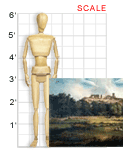From the collection of:
The Filson Historical Society || VAM Home
Clement Reeves Edwards (American, 1820-1928)
CHAPULTEPEC, c. 1848
Oil on canvas; 37-3/4" X 53-1/2"
1979.13.3, Bequest of Catherine Noble Ingram
The Filson Historical Society
Chapultepec is a 1,600-acre park in Mexico City, originally developed as a residence for Aztec rulers. A castle built on a hill there in the late 18th century as a summer home for the Spanish viceroys later became the traditional home of the rulers of Mexico. Chapultepec, heavily fortified, was also the scene of spectacular fighting during the U.S.-Mexican War. American Gen. Winfield Scott ordered it to be stormed on September 12, 1847, and it fell the next day. But its heroic defenders, particularly the “boy heroes” from the adjoining military college who preferred death to surrender, became a symbol of glory for Mexicans.
 Self-Portrait
Self-Portrait by Edwards
Both Emperor Maximilian and Porfirio Díaz beautified the grounds and embellished the castle. In 1937, Mexican President Lázaro Cárdenas declared it a museum of colonial history and ethnography. Today the park includes several museums, including the world-famous National Anthropological Museum; a boating lake; two amusement parks; and a zoo.
In this painting of Chapultepec, bright blue sky peeks out from behind feathery pink and gray-blue clouds. The landscape beneath is dappled in light. The building is raised high toward the center of the painting, half-lit on a plateau with a ramp leading up to it. The trees surrounding the plateau vary from dark to bright green, emphasizing the play of light. A little wall beneath the plateau separates the dense trees from the livestock meandering in the foreground of the painting among the dark foliage. This painting was conserved in 1983.
About the Artist
Although not well known nationally, Clement Reeves Edwards gained a reputation as a regional artist of the 19th century, primarily painting landscapes and portraits.
Edwards was born in Salem County, New Jersey. His career as an artist began with an apprenticeship to a sign painter in 1838. He soon opened his own studio and began painting portraits. He is thought to have lived in New Jersey, Ohio, Pennsylvania, and Maryland. In March of 1847, he enlisted in the First Maryland Regiment and fought in the U.S.-Mexican War. Upon his discharge in 1848, he moved first to Cincinnati, then to Louisville, and finally to Bowling Green, Kentucky, where he set up a photography and portrait studio. He took up farming in 1871 and died in 1898.
In 2005, Edwards’ painting Mammoth Cave in 1859, held in the collection of the Kentucky Library and Museum at Western Kentucky University, was sent to Latvia for display at the United States Embassy there.
Classroom Ideas
Discussion: Were you able to determine the country depicted in this painting based on the landscape and/or architecture you see? What are the distinctive features of each?
Activity: Learn more about Aztec architecture. What materials did the Aztecs commonly use? What styles or methods of building? Can you find traces of Aztec influence in modern architecture?
Links
See pictures of the Chapultepec castle at Castles of the World.
[www.castles.org/castles/America/Mexico/Chapultepec-MexicoCity/]
Read about the Edwards painting in Latvia in Western Kentucky University’s online pressroom.
[www.wku.edu/news/releases05/june/latvia.html]

